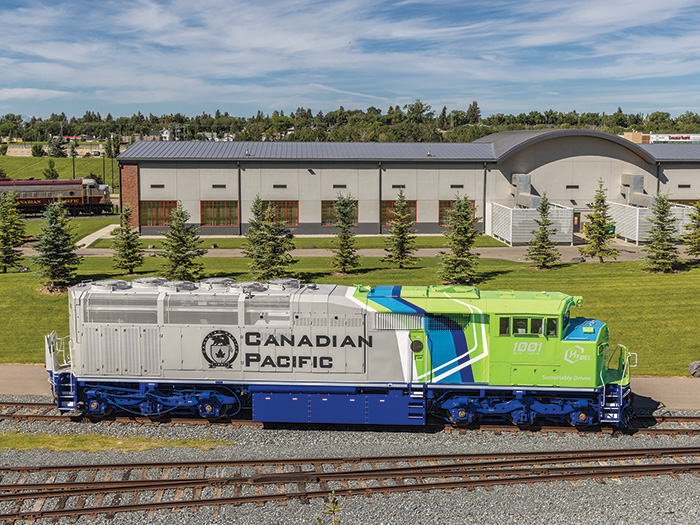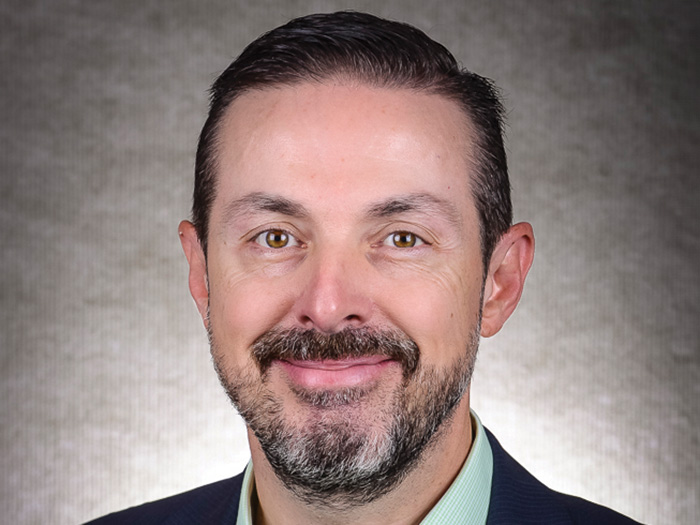Get On Board or Be Left at the Station: How Sustainable Fuels Are Revolutionizing Freight Transportation and Insurance

The movement to halt climate change has many fronts. The transportation sector, for one, is the U.S.’s largest emitter of carbon dioxide, and internal combustion engines are a frequent target of emission-reduction measures.
In some respects, these measures have been a success; electric vehicle sales are projected to jump 35% in 2023, smashing last year’s record-setting figures. But not all forms of transportation are as amenable to battery power as are cars and trucks. Especially when it comes to freight trains, ships and planes, battery power is simply not up to the task.
To fully transition the transportation industry to sustainable, net-zero fuels will require heavy investment in emerging technologies that hold enormous promise — but carry unknown risks.
“As the shipping industry looks to decrease its carbon footprint for social, economic and regulatory reasons,” said Michael Gosselin, global leader of energy and transition risk, Liberty Mutual, “insurers really are a key resource in helping companies understand the potential risks of that transition and how to mitigate and manage those new exposures.”
The Drive to Deliver
The push for a net-zero freight industry is spurred largely by grassroots demand and investors eager to see more flattering annual sustainability reports.

Charlie Sidoti, executive director, InnSure
“A lot of these changes are being driven by consumers,” said Charlie Sidoti, executive director of nonprofit climate change insurance industry association InnSure. “You can lead innovation, you can follow innovation, but if they don’t participate somewhere along that transition spectrum, companies are going to wake up and they’ll be out of step with the market, their consumers and their competitors, and that’s not a good place to be in, just from a pure business perspective.”
“In some cases, there’s also regulatory pressure,” added Francis Bouchard, managing director of climate, Marsh McLennan Companies. “There’s another cost associated with not being part of the transition, because regulators find ways to really nudge you along. We’re seeing that in the disclosure space quite heavily, where more and more regulators are demanding certain forms of disclosure, and I think you’ll start to see similar versions of that extended to other sectors.
“And specifically in large-scale transportation, like ships and trains, when you invest in infrastructure and it lasts for 50 to 75 years, they’re not going to throw away vehicles,” Bouchard added. “Companies are making decisions and investing money today that has to fit into a market that’s going to be here in 20, 30, 50 years. It’s really important that they get those things right on the regulatory front, on the market front and on the technology front.”
“As the shipping industry looks to decrease its carbon footprint for social, economic and regulatory reasons, insurers really are a key resource in helping companies understand the potential risks of that transition and how to mitigate and manage those new exposures.” — Michael Gosselin, global leader of energy and transition risk, Liberty Mutual
In April, for instance, the California Air Resources Board passed a regulation that will require freight rail lines to be emission-free by 2035. But experimental battery-powered locomotives can operate at full horsepower for only about 30 minutes, and biodiesel, while less carbon-intensive than diesel, will not get the rail industry to net-zero alone.
This makes full fleet conversion on such a tight timeline a practical impossibility for the state’s Class III rail, according to a statement from Chuck Baker, president of the American Short Line and Regional Railroad Association.
It’s vital for transportation groups to “engage proactively and earnestly about what challenges they face, what’s technologically feasible,” said Craig Stanfield, a partner in the trial and global disputes group at King & Spalding. “At the end of the day, regulators, particularly those on a more local level, understand the importance these industries add to their citizens.”
And “if there’s regulation that’s put into effect and there’s a view that the regulators didn’t take the full record into account, didn’t develop a proper record, there’s litigation that comes out of that,” Stanfield continued. “I suspect we’re not going to see any shortage of litigation as more regulations come down the pipe.”
A Steep Hill to Climb
For the transportation companies committed to transitioning to net-zero fuels, the challenges are daunting, from hiring or reskilling workers to securing a fuel supply chain — and, above all, cost.
While it’s more practical to convert existing vehicles than to replace a fleet entirely, retrofitting a diesel locomotive with hydrogen fuel cells currently runs about $10 million.
New sources of funding — the Infrastructure Act, the Inflation Reduction Act — could help to offset these costs, and new alternative fuels may well prove cheaper than fossil fuels over the long term.
Nevertheless, fleet upgrades represent a steep upfront cost for a sector that often operates on slim margins, especially given that an investment in vehicle upgrades represents a commitment to a technology that may not take off.
And while “insurance companies shouldn’t try to pick winners and losers” among emerging fuel sources, Stanfield said, “they get to view a broad swath of every industry and may be able to bring that to bear in terms of risk mitigation.

Craig Stanfield, partner, King & Spalding
“We’re going to have to develop more new projects. We’re going to need really great builder’s risk policies. We’re going to need good business interruption policies. We’re going to need good policies that cover the transportation of freight, even if it’s a new technology that may not be as well known,” Stanfield continued. “And then, even though it’s not really an insurance product in the traditional sense, we’re going to need the sureties to come and bond these projects and contracts.”
“Without insurance, project finance doesn’t happen,” Gosselin agreed. “We do play a role in helping understand the overall volatility of this new technology, how we can minimize and manage it, and then how we use best practices.”
Which is to say: Even fully funded, there are still many technical hurdles to overcome — not least of which are the physical risks.
“When we think about the safety implications of the new fuel,” Gosselin said, “when you put it in operation, is it stable? How are accidents caused, and how do we think about leaks and ignitions? What’s the carbon footprint of the new equipment needed?
He continued: “We’re looking at hydrogen, new battery storage, you name it. Can that new fuel be safely transported and stored in sufficient quantities? When we think about the new hydrogen super hubs that are being developed — it’s fine to provide the supply, but you need to build the entire new demand network out. That requires a lot of thoughtful progress and working with multiple stakeholders.”
Finally, Gosselin said, “it gets back to employee training and the need to ensure the safety of staff and the public … How we deal with that effectively in the community is going to be key.”
Lighting the Darkness
That risk, of course, is where underwriters come in. But transferring risk relies on actuarial science, an inherently backward-looking discipline. How can they make predictions with so little historical data to rely on?
One solution, said Bouchard, is “to develop proxies for the new exposures that the new technologies are creating. We need to understand what is new and what isn’t new about these risks, as opposed to saying ‘Oh, it’s an EV battery — I don’t know anything about it.’ There’s probably more you know about it than you think.
“But then there’s probably still a chunk that we need to somehow, whether it’s through machine learning or through analogous risks. We need to find proxies so we can adequately price and facilitate the deployment of these technologies. Simply relying on actuarial data that looks backward is going to be too slow and probably not responsive to market needs.”
Hydrogen fuel cells, for instance, are an emerging technology, and rail companies are just beginning to experiment with generating hydrogen on site. But the oil and gas industry has been using hydrogen for years, and there are those with expertise in working with it safely.
“We’ve been writing traditional energy for over 25 years, so we have a lot of knowledge in the hydrogen that’s used in traditional oil and gas right now,” Gosselin said. “In some new technologies, you don’t have 20 years of actuarial data, but we can work our way through a lot of what we see.”
“From a technical perspective, we need to be a step ahead, perhaps, of the technology that we’re moving to,” Sidoti added. The actuarial view is “one of the strengths of the industry, but it’s also this weakness, because [it’s] backwards-looking … There are engineering approaches that are more forward-looking that the industry needs to embrace.”
Climate Is a Team Sport
To overcome a lack of claims history, underwriters whose clients use emerging fuel sources will need to find partners that understand the risks and expand their own knowledge.
“We’ve been investing heavily in understanding different technologies through our risk engineering and advisory groups and really looking at how we build effective risk-assessment frameworks,” said Gosselin.
“We’re using the best minds, both within the company and also externally with our brokers and clients,” Gosselin added. “The government’s also involved, and partnerships with academia.” Success will be built on “how we work together as a group to help the transition move forward.”
“Climate is a team sport,” Bouchard agreed. “No one is going out there and saying, ‘I’m going to solve this alone.’ It’s about partnerships, particularly partnerships that have never existed before … The way it will be solved is by bringing in others who have similar experiences and who can inform the underwriting process. Partnership is going to be an absolutely critical success factor in this.
“It’s not something the insurance industry has necessarily done well on a large-scale basis, but it’s something that it’s going to have to learn to do, because that’s where the answers are going to be.” &
The preceding is Part 1 of a three-part series on insuring the energy transition in the freight transportation industry. Part 2, which explores the risks and benefits of publicizing a formal ESG platform, can be read here. Part 3, a look at the technical challenges insurers must consider when underwriting and benchmarking emerging fuel technologies, can be read here.










